Our last night in Estonia was spent in Pärnu, like Haapsalu an old resort town, and still the most popular beach town in the country. Our first order of business after reaching our hotel – a small, newer place right in the old town – was finding dinner. After being ignored at one place, and turned away at another, we settled on an uncrowded Armenian restaurant. The staff was friendly, even though the food was a bit disappointing. We had hoped that it might be more authentic. The patrons in the patio did seem to be authentic Armenian families with children
Our “boutique hotel“, had a stunningly and sleekly appointed room with beautiful multi-toned grey, tan, and white décor, but it turned out to be highly impractical and somewhat uncomfortable. Having a number of guest rooms in our own house, I am keenly aware that people need vertical surfaces on which to put their own things and convenient access to fixtures. Additionally, this room faced west. Curtains open and windows closed made it an oven. Given we were still not fully time adjusted and the room contributed to our discomfort, we awakened very early the next morning with the doves and seagulls at our windows.
We took advantage of our early rising to stroll around the old town in the quiet morning, before there was any stirring amongst the human residents. Just as there were long evenings, so, too, there were long mornings starting in the wee hours. Like many of the other tourist-oriented towns we visited, Pärnu has a central core that is pedestrian only. These designated areas are often lined with picturesque older buildings, from grand churches to modest wooden houses. It was nice to have the place to ourselves, sharing it mainly with the local hooded crows, colorful relatives of our familiar black crows. A large flock of these birds had found the perfect breakfast in an overturned garbage can behind a restaurant. We took some pictures of the cheeky corbids, but the photos were a bit too blurry. This handsome fellow was found on-line at http://ournaturezone.com.

Hooded crow, the common species of crow in the Baltics
Pärnu was a trading town from ancient times, and the current old town was once enclosed in walls, built by the Swedes when they controlled the area. Only one (north) gate still remains, guarding the road to Tallinn, but much of the wide earthen rampart area is now a park which encircles the eastern part of the old town. Tiled plazas outline where the projecting bastions once were. It was a very illustrative way to incorporate the memory of the fortifications into the modern town.
The morning light was beautiful, especially on the old buildings and churches. I think that it is in this town that I became fascinated by brick buildings against blue skies and the ornate architecture of Orthodox churches. I’ll share some of these here and try to restrain myself from enthusiastically showing off page after page of churches and the tops of building.
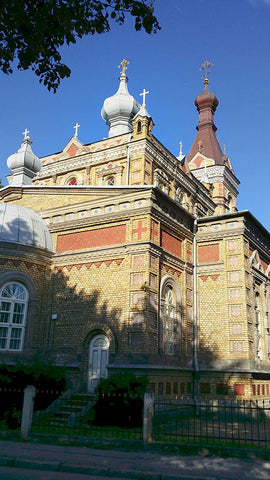
Orthodox church, Pärnu
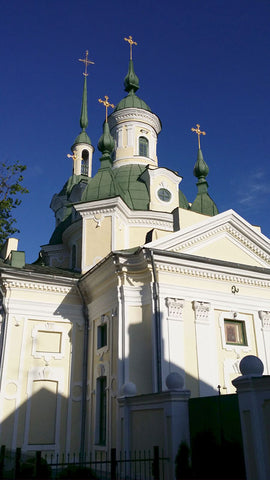
St. Catherine's Orthodox Church, Pärnu

Brick facade, Pärnu
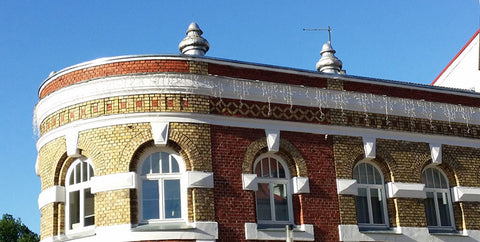
Brick facade and blue sky, Pärnu
Of course, as in almost all the towns and squares in the Baltic countries in which we traveled, there were great public displays of flowers in Parnu.
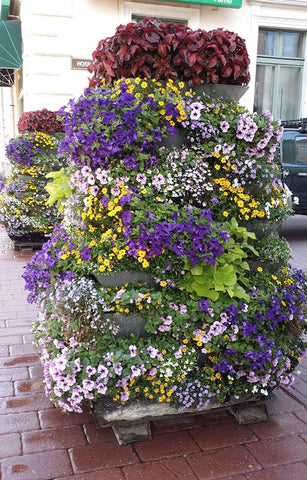
Street flowers, Pärnu old town
After our walk, we had a lovely breakfast in the restaurant associated with our hotel. The hostess had a PERFECT Australian accent which I mistook as an Australian background. No, seems she was there as a student for a few years; she was an Estonian. We bid Pärnu goodbye, headed for the coast road and were FINALLY on our way to Latvia!
The drive from Tallinn to Haapsalu was dominated by the mysterious Estonian countryside. We spent miles and miles driving through endless acres (or to be European, hectares) of very flat hay fields. Some had round or rectilinear hay bales dotted on the mowed fields. The odd thing was that we saw almost no animals. Perhaps, a hundred cows all told. No horses, sheep, or even people. The occasional farm house or barn, but no life -- very Twilight Zone.
All that changed in Haapsalu, an old spa resort town, historically renowned for its restorative mud, rich in trace minerals. This healing mud made Haapsalu a destination for people from countries far and wide wishing to be cured of aches and pains. The town boasts having the Russian Imperial family (including Alexander I, II and III, Peter I and Nikolai II) among its guests. You can still find spas and rehabilitation centers there. This, however, was not our reason for going. I wanted to go to the Haapsalu Lace Center to see the (small) museum, and see if there was a shawl that needed to come home with me.
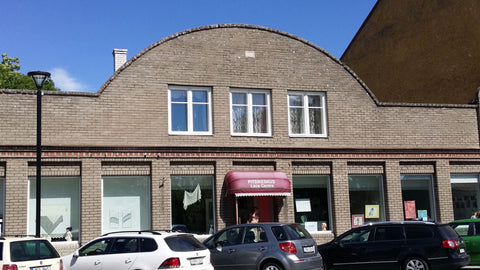

The Haapsalu Lace Center
What a lovely selection of shawls! After somewhat halting conversations with the Estonian women who were manning the shop, I bought a large square shawl with a traditional design, a new book “Estonian Knitting 1. Traditions and Techniques” (http://epood.saara.ee/en/pood/estonian-knitting-1), the first in a series, AND a ball of yarn for a forthcoming shawl knitting project of my own.


Ilga's Haapsalu lace shawl
I chose this shawl because of it's extremely fine and beautiful crafts(wo)manship and the simple central pattern looked very nice when folded over into a triangle (as I am likely to wear it). It was certainly a very difficult choice to make. A bit pricey, so I had to chose just one from the scores of gorgeous shawls!
After our mission was accomplished, we walked around the town and on the sandy land along the inlets dotted with reed islands sporting many birds. It was deceptive, we thought we could walk out onto the shore, but the reedy swamps inhibited our exploration as did the positively gale force winds. It was actually hard to stand up or even hold the camera steady. A few hardy sunbathers were lying on the beach nonetheless.

The shore at Haapsalu
From there, we retreated back to the town to look at some of the wonderful ‘wooden lace’ buildings (what we would call ‘gingerbread’----Isn’t ‘wooden lace’ so much more descriptive?) and the remains of the old bishop’s castle, once the seat of government for this part of Estonia.
Mike walked quickly around the ruins, while Ilga waited in the shade of a tree and people-watched while knitting. The castle is a big place, renovated many times during its history, and is currently being restored. A city park has been established around it, including a children’s playground in part of the old moat.

Bishop's castle

Church and tower at Bishop's castle

Gate at Bishop's castle

View from Bishop's castle

View from Bishop's castle
Then we drove through the even emptier countryside – just hayfields scattered here and there, surrounded by stands of trees. Very flat, with few signs of habitation. We came upon the village of Lihula – a rare hill in the plains. This was the site of an ancient hill fort, which had been replaced by a German crusader castle, then by a Swedish castle, then by a manor house. One had a sense of the many layers of history lying together, making for a very evocative site.
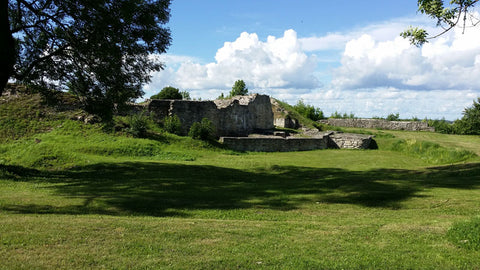
Lihula castle ruins
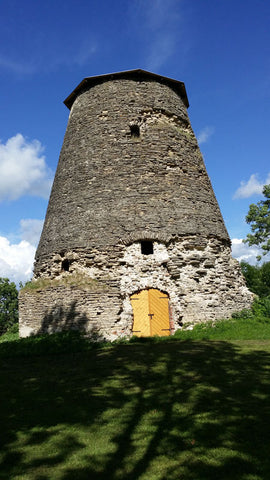
Tower at Lihula castle ruins
In the village itself, we found the striking ruins of an old red brick and stone Orthodox church, now roofless and colonized by trees. It seemed of a piece with the ruins back up on the hill. After a few photos there, we got back on the road, and made it the rest of the way to Pärnu, our stop for the night.
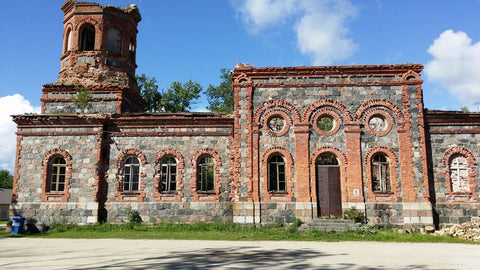
Abandoned Orthodox church
Tallinn’s old town, a UNESCO World Heritage Site, is a remarkably picturesque, medieval town with many 14th to 17th century buildings, beautifully preserved and maintained. I hate to admit that I slept much of the time while we were there. Between the jet lag and the long journey, I was really quite exhausted. Mike recovered more easily and “cased out the town” while I slept -- so I didn’t miss the architectural highlights. He would come back to our pretty hotel and talk of how crowded it was. However, when I would accompany him in the evening, the city was quiet, with a modicum of tourists for such a lovely place. Turns out that during the day the town is infiltrated by hundreds of cruise ship tourists, in gaggles following their banner-carrying guides. At round 5:00pm, they are marched back to their ships for (I imagine) their evening meals. Given the long evenings, that left us hours to wander the cobbled streets in relative calm. Given the dubious weather (it threatened to rain constantly), the skies were quite dramatic, which enhanced the pretty town.

Street scene in Tallinn Old Town

Steeple of St. Nicholas Church, Tallinn Old Town
I was particularly enraptured by the old abbey gateway -- one of the oldest surviving structures in the city.

Detail of arch, St. Catherine's Cloister
Our hotel was on a little plaza that had a gazebo in the middle. A few times a day, various groups of musicians in period costumes would play medieval music. It was a charming touch. We saw a number of street musicians throughout the town, playing everything from medieval recorder and bagpipe music to “Cotton Fields Back Home” (which the band on the ferry from Helsinki had played, too).

Street musicians outside our hotel
Many of the houses in old town Tallinn are traditional tall and narrow merchant houses. The top floor of these houses would have been used for goods storage with stored items moved up and down via a pulley system. Some of these houses still have the pulley rigging in place.

Merchant's house with pulley hoist
Above the old town of Tallinn stands the citadel hill, known as Toompea. This houses the town’s major churches, as well as the Parliament building. Some of the old fortress walls and towers are still standing, including one known as Kiek in de Kök, or “peek in the kitchen”, since those in the tower could spy on the houses below. Some of the lower town walls are accessible, as well, giving view down into the streets of the town. Some of the original town gates still offer passage between the old town and the new.

View of Kiek in de Kök

View from the lower town walls

Viru gate leading from the Old Town to the new.
One evening, we had a spectacular dinner at the Hermitage Restaurant (adjacent to our hotel). Having been very warm all day, we ate outside next to the gazebo. This turned out to be the finest meal of our trip. A highlight was my dessert, called a “deconstructed cheesecake”, served in a small fishbowl and looking like a miniature garden.

Deconstructed cheesecake at the Hermitage Restaurant
After a couple of nights in Tallinn, and jet lag recovery mostly completed, we picked up our rental car and set off for Haapsalu, the first fiber-focused stop of the trip…




























